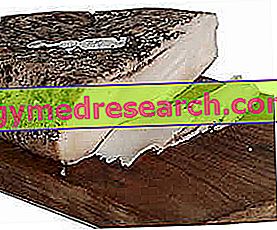What is Lardo
Lard is a product of norcineria obtained exclusively from the processing of heavy pork ( Sus scrofa domesticus fattened); this derivative of pork is therefore the result of the processes of handling and maturing fresh meat, which is why it is part of the group of preserved salted meats (cured meats).

Good quality lard is sold in pieces with variable weights from 250g up to 5.0kg, with NEVER thicker than 3.0cm. It has the shape of a flattened parallelepiped, possibly covered by the rind on one side and the spicy salt on the other; in the part exposed to the cut, before the vacuum packing for the marketing, a synthetic protective tissue is applied.
NB . Lard is a food subjected to a strong peroxidative deterioration, since it contains high quantities of saturated fats (unsuitable for storage but useful in cooking) and very few antioxidants; therefore, by keeping the lard too long and subjecting it to sudden changes in temperature, air and light, the process of rancidity of the surface layer accelerates significantly.
Types of fine lard
Lardo di Colonnata
Lard "di Colonnata" (PGI - Protected Geographical Indication - CEE 2081/92) is treated with: natural sea salt, ground black pepper, fresh rosemary and peeled and coarsely chopped garlic (optional: cinnamon, star anise, coriander, nutmeg, cloves and other aromatic herbs, in particular sage, oregano or any other food that is edible and that grows spontaneously in the Apuan Alps).
The "di Colonnata" PGI lard ages for about 6 months and involves the use of containers made of marble basins, within which - during the maturation and by salt - the formation of the typical brine occurs spontaneously.
Lard of Arnad
lard "di Arnad" (PDO - Protected Designation of Origin - EEC 1263/96) is skinned and treated with brine based on: sea salt, pepper, rosemary, bay leaves, sage, cloves, cinnamon, juniper, nutmeg and yarrow; it matures for about 12 months and in the past it was stored in "doils" made with chestnut wood, while today (for hygienic reasons) the containers are made of glass. The stratified lard is then sealed and sometimes added to white wine.
Recipes and nutritional characteristics
| Nutritional composition of Lard - Reference values of the INRAN Food Composition Tables | ||||||||||||||||||||||||||||||||||||||||||||||||||||||||||||||||||||||||
 | ||||||||||||||||||||||||||||||||||||||||||||||||||||||||||||||||||||||||
Nutritional values (per 100 g of edible portion)
| ||||||||||||||||||||||||||||||||||||||||||||||||||||||||||||||||||||||||
Lard is a cured meat used mainly as a dish; it goes very well with toasted bread or tigelle or fried pinzini and goes to make bruschetta of great gastronomic value; it goes happily with garlic and honey, while the accompanying wine is mainly white or rosé. There are also culinary preparations of dishes and pasta dishes that involve the use of lard; it is an excellent cooking medium and brilliantly replaces seasoning fats. Stuffed lean meats like rabbit (to be prepared in porchetta), game or rolled up. The combination with shellfish and other fishery products (for example, shrimp in a brandy scarf) is curious. Used to produce a fast ragù (raguttino), it is associated with truffles and aged cheeses to accompany potato gnocchi, pumpkin cappellacci and egg pasta in general.
From a nutritional point of view, lard is certainly a food of the past; like most cured meats, and perhaps more than others, it represents a large energy source to be used with great parsimony. The contemporary lifestyle does not provide levels of overall physical activity such as to allow the systematic and frequent use of lard as a dish on its own, even if, as for other foods, it is always "the dose to make poison". Lard can replace oils in cooking, but in this way it would give up the intake of vitamin E and the correct ratio of saturated and unsaturated fatty acids.
Being made of dehydrated adipose tissue by seasoning with salt, the lard contains very high amounts of fat, in particular saturated, and obviously there are notable portions of cholesterol. This makes lard a food unsuitable for those suffering from hypercholesterolemia and those who are overweight or obese, even though the fatty acids profile shows excellent amounts of monounsaturated and polyunsaturated fatty acids. Carbohydrates are absent and, interestingly, proteins too.



